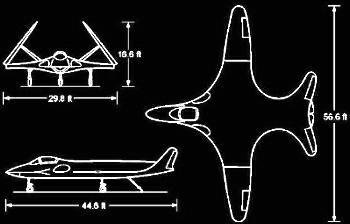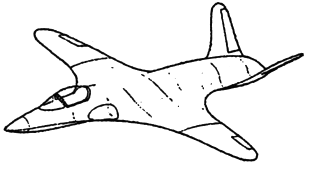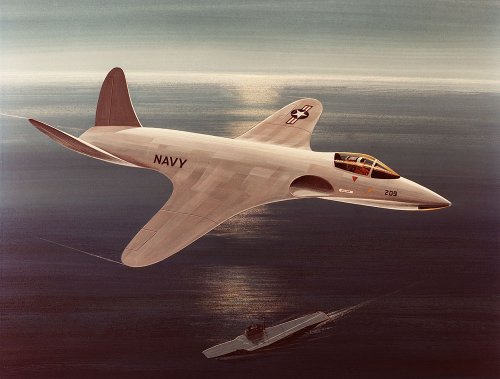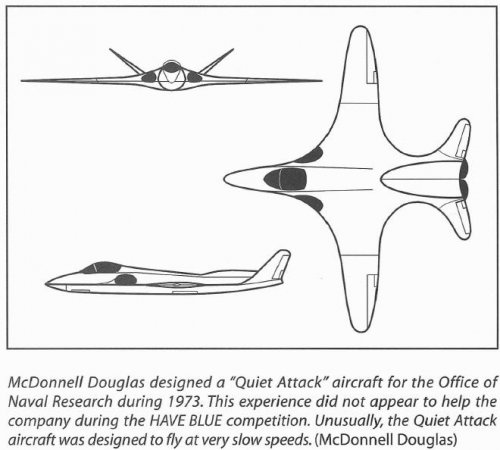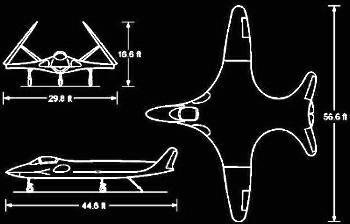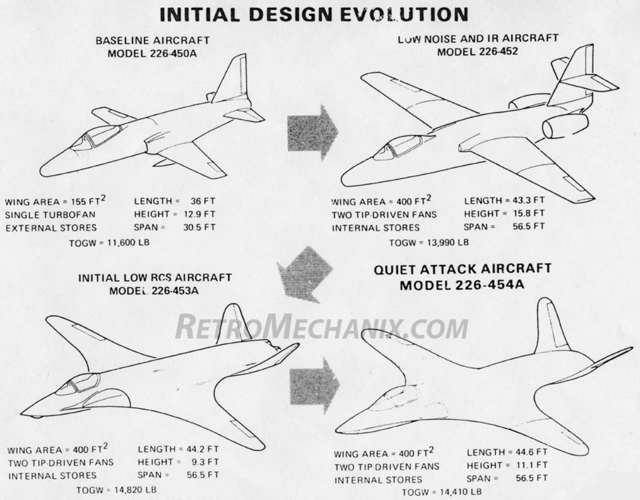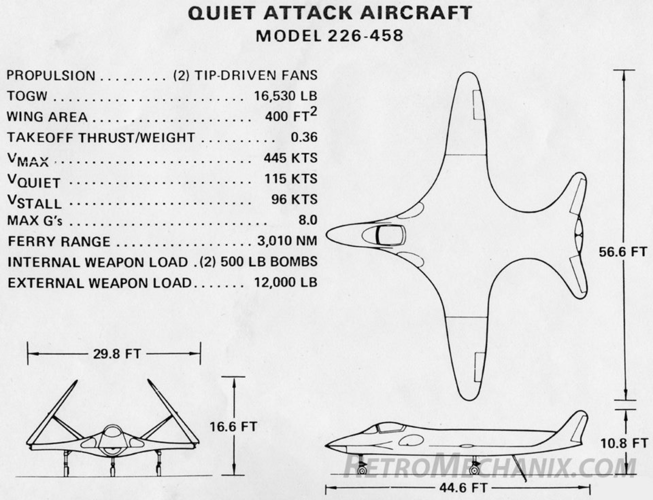You are using an out of date browser. It may not display this or other websites correctly.
You should upgrade or use an alternative browser.
You should upgrade or use an alternative browser.
McDonnell-Douglas Model 226 "Quiet Attack Aircraft" : Early Naval Stealth study
- Thread starter Matej
- Start date
- Joined
- 26 May 2006
- Messages
- 34,912
- Reaction score
- 15,789
Hi,
I want to know the McDonnell Douglas XST proposal,that because the USAF
in 1975 awarded the contracts,to Northrop and MD,but there was a private
venture from Lockheed,did we speak about this proposal before ?.
I want to know the McDonnell Douglas XST proposal,that because the USAF
in 1975 awarded the contracts,to Northrop and MD,but there was a private
venture from Lockheed,did we speak about this proposal before ?.
- Joined
- 1 April 2006
- Messages
- 11,397
- Reaction score
- 10,314
We did. It wasn't XST. It was Quiet Attack Aircraft
DEVELOPMENT OF THE F-117 NIGHTHAWK
As a follow-up to Harvey and other research programs, DARPA sent out RFPs for
competitive study contracts to Northrop, McDonnell-Douglas, General
Dynamics, Fairchild, and Grumman in 1974 to develop design concepts for a
very low RCS combat aircraft.11 Only the first three firms responded. Lockheed
also soon joined the competition.12 Its engineers developed a highly
unconventional faceted design nicknamed the “Hopeless Diamond,” which
contained only two-dimensional flat surfaces. This was because RCS could only
be calculated with high precision for two-dimensional surfaces given the state
of knowledge and the capability of computers at the time. Northrop proposed a
more conventional delta-wing stealth design with the air inlet on top, which
used a combination of angular and rounded surfaces.13 McDonnell proposed a
variant of its “Quiet Attack” aircraft design that had been developed earlier
under a contract for the Office of Naval Research. DARPA soon realized that
both Lockheed and Northrop had proposed design concepts that were
revolutionary in their potential to reduce RCS. In October, DARPA awarded
these two companies follow-on contracts to develop their design concepts
further. The two companies built models of their designs, which engineers then
tested in early 1976 on a fixed pole in a competitive “fly-off” at the Air Force’s
radar range in New Mexico. In April, DARPA informed Lockheed that it had
won the competition.
Scott builds a master for it of it - just in case http://www.up-ship.com/models/stealth2.htm
DEVELOPMENT OF THE F-117 NIGHTHAWK
As a follow-up to Harvey and other research programs, DARPA sent out RFPs for
competitive study contracts to Northrop, McDonnell-Douglas, General
Dynamics, Fairchild, and Grumman in 1974 to develop design concepts for a
very low RCS combat aircraft.11 Only the first three firms responded. Lockheed
also soon joined the competition.12 Its engineers developed a highly
unconventional faceted design nicknamed the “Hopeless Diamond,” which
contained only two-dimensional flat surfaces. This was because RCS could only
be calculated with high precision for two-dimensional surfaces given the state
of knowledge and the capability of computers at the time. Northrop proposed a
more conventional delta-wing stealth design with the air inlet on top, which
used a combination of angular and rounded surfaces.13 McDonnell proposed a
variant of its “Quiet Attack” aircraft design that had been developed earlier
under a contract for the Office of Naval Research. DARPA soon realized that
both Lockheed and Northrop had proposed design concepts that were
revolutionary in their potential to reduce RCS. In October, DARPA awarded
these two companies follow-on contracts to develop their design concepts
further. The two companies built models of their designs, which engineers then
tested in early 1976 on a fixed pole in a competitive “fly-off” at the Air Force’s
radar range in New Mexico. In April, DARPA informed Lockheed that it had
won the competition.
Scott builds a master for it of it - just in case http://www.up-ship.com/models/stealth2.htm
Attachments
Just call me Ray
ACCESS: Top Secret
- Joined
- 26 August 2007
- Messages
- 672
- Reaction score
- 55
...is it merely "coincidental" that McDonnell was also responsible for the XP-67 Moonbat? 
XP67_Moonbat
ACCESS: Top Secret
- Joined
- 16 January 2008
- Messages
- 2,271
- Reaction score
- 544
Moonbat, aye! I heard my name. You rang? ;D
OM
ACCESS: Top Secret
Just call me Ray said:...is it merely "coincidental" that McDonnell was also responsible for the XP-67 Moonbat?
...Oh, so *they're* the ones responsible for Moonbat
Just call me Ray
ACCESS: Top Secret
- Joined
- 26 August 2007
- Messages
- 672
- Reaction score
- 55
According to a post at Above Top Secret (here: http://www.abovetopsecret.com/forum/thread202776/pg1 ) the prototype XST was buried in the desert with "other black programs," and was slated to be unearthed and restored but it has since been misplaced.
I don't think there's any real reason to believe this though.
I don't think there's any real reason to believe this though.
- Joined
- 6 August 2007
- Messages
- 3,895
- Reaction score
- 5,985
Just call me Ray said:According to a post at Above Top Secret (here: http://www.abovetopsecret.com/forum/thread202776/pg1 ) the prototype XST was buried in the desert with "other black programs," and was slated to be unearthed and restored but it has since been misplaced.
I don't think there's any real reason to believe this though.
Unlike most posts on that board, that one originally comes from a very reputable source.
What is really interesting is that Lockeed was also working on a LO project for the Navy at the same time McD was working on the Quiet study. Wether they were part of the same program I do not know, but it was this work that eventually lead to ECHO 1. Lockheed was still working from their successes with the Blackbird and D-21 program, while later the ECHO1 tools allowed them to leap beyond that.
XP67_Moonbat
ACCESS: Top Secret
- Joined
- 16 January 2008
- Messages
- 2,271
- Reaction score
- 544
What type of exhaust was planned for the McDonnell bird. The aft end isn't too clearly defined.
- Joined
- 27 December 2005
- Messages
- 17,752
- Reaction score
- 26,437
- Joined
- 27 December 2005
- Messages
- 17,752
- Reaction score
- 26,437
Quiet Attack Specs:
Length : 44.6 ft
Span: 56.5 ft
Takeoff weight: 14,410lb
Empty weight: 9,960lb
Fuel : 3415lb
Wing area: 400 sq ft
Aspect ratio: 8
Takeoff thrust/weight ratio: 0.44
Quiet speed, 2500ft altitude: 112kn
Max speed, 2500ft altitude: 400kn
High-bypass, tip driven turbofan
Plug nozzle
Source: Have Blue and the F-117A: evolution of the "Stealth Fighter" By David C. Aronstein, Albert C. Piccirillo
Length : 44.6 ft
Span: 56.5 ft
Takeoff weight: 14,410lb
Empty weight: 9,960lb
Fuel : 3415lb
Wing area: 400 sq ft
Aspect ratio: 8
Takeoff thrust/weight ratio: 0.44
Quiet speed, 2500ft altitude: 112kn
Max speed, 2500ft altitude: 400kn
High-bypass, tip driven turbofan
Plug nozzle
Source: Have Blue and the F-117A: evolution of the "Stealth Fighter" By David C. Aronstein, Albert C. Piccirillo
Now what, pray tell, is a "tip-driven turbofan?"
- Joined
- 4 May 2008
- Messages
- 2,439
- Reaction score
- 762
Similar to Ryan XV-5, except the fan is positioned upright for propulsion, as opposed to flat for lift.
Basically you have a gas generator, whose exhaust is channeled into a scroll surrounding a fan, and impinging on a tip turbine stage concentric to said fan. The gas generator and the fan need not be close together, as you can duct the exhaust quite a ways, but you then incur duct losses.
I believe the interest in this particular case might have been to achieve a diluted exhaust temperature for signature purposes.
Basically you have a gas generator, whose exhaust is channeled into a scroll surrounding a fan, and impinging on a tip turbine stage concentric to said fan. The gas generator and the fan need not be close together, as you can duct the exhaust quite a ways, but you then incur duct losses.
I believe the interest in this particular case might have been to achieve a diluted exhaust temperature for signature purposes.
Just posted an article on this aircraft study at RetroMechanix.com, along with 8 images:

The article features some CG artwork I did several years back. Special thanks to Mark Nankivil for letting me post the contemporary artist's impression from the Greater St. Louis Air & Space Museum. I believe the article presents information that has not been published before, so please check it out when you have a moment.
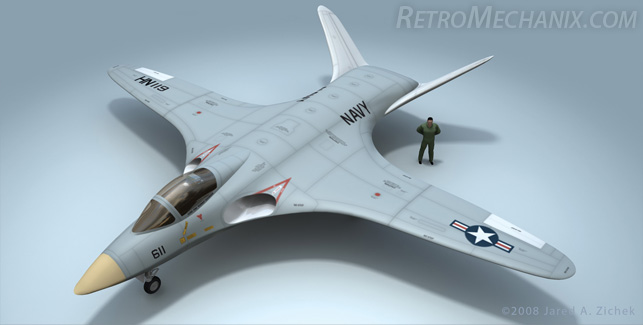
The article features some CG artwork I did several years back. Special thanks to Mark Nankivil for letting me post the contemporary artist's impression from the Greater St. Louis Air & Space Museum. I believe the article presents information that has not been published before, so please check it out when you have a moment.
- Joined
- 25 June 2009
- Messages
- 14,754
- Reaction score
- 6,155
Thanks Jared for this great article and fantastic graphics. You've really made this project stand out!
I still wonder what ties existed between the McDonnell Model 226 program and the "Marshmallow" design that shares some design similarities with it. Any ideas?
I still wonder what ties existed between the McDonnell Model 226 program and the "Marshmallow" design that shares some design similarities with it. Any ideas?
- Joined
- 3 June 2006
- Messages
- 3,094
- Reaction score
- 3,966
...Lt. Cmdr. Tom "Iceman" Kazansky....  ;D
;D
Great Article so far!!!
Great Article so far!!!
- Joined
- 27 December 2005
- Messages
- 17,752
- Reaction score
- 26,437
Stargazer2006 said:Thanks Jared for this great article and fantastic graphics. You've really made this project stand out!
I still wonder what ties existed between the McDonnell Model 226 program and the "Marshmallow" design that shares some design similarities with it. Any ideas?
"Marshmallow" was a fictitious design used to represent General Dynamics' "stealthy" ATF concept, as the Sneaky Pete/HAVE KEY derived design was classified. It is unlikely to have any direct relation to Model 226 unless the artist who drew it was aware of the 226 design and used it as inspiration. It conforms to the typical idea of stealth pre-F-117 and has similarities to Quiet Bird, and the Rockwell Flying Banana...
Marshmallow
Quiet Bird
Flying Banana
Re: McDonnell-Douglas Model 226 "Quiet Attack Aircraft": Early Naval Stealth
Thanks for the kinds words all! I'm not entirely sure of the relationship between the McDonnell Douglas QAA and the other studies mentioned; hopefully more information will come to light in the years ahead, but it may be a while...
Thanks for the kinds words all! I'm not entirely sure of the relationship between the McDonnell Douglas QAA and the other studies mentioned; hopefully more information will come to light in the years ahead, but it may be a while...
- Joined
- 4 May 2008
- Messages
- 2,439
- Reaction score
- 762
if it helps, i sent the link to your article to two people who worked on the "flying banana" and the "surprise fighter", both contemporary studies from other companies. Maybe they can weigh in with additional details.
- Joined
- 4 May 2008
- Messages
- 2,439
- Reaction score
- 762
I got a reply from Dave Hall, the designer of the "Flying Banana"
also see "silent night" design. Some of its background is retold on this page:
http://www.fantastic-plastic.com/SilentStealthCatalogPage.htm
My Rockwell study was for ONR from June 1971 to October 1973 and was focused on simultaneously minimizing radar, infrared, acoustic, and visual signatures at the expense of performance and even utility in order to set an upper or lower bound on what the answer had to be. The threat was SA-2 and SA-3 SAMs and, specifically, their metric wavelength radars. As the study wound down, ONR offered Rockwell a sole-source follow-on which the division president turned down to focus on augmenter wing VTOL. His exact phrase was "we're putting all our eggs in one basket". ONR begged us to build scale models to fly against the U.S. russian radar site and he said no. We did the flying banana for a combination of this later study that McDAC got and an AF bid opportunity before being told to no-bid unless there was an augmenter involved.
also see "silent night" design. Some of its background is retold on this page:
http://www.fantastic-plastic.com/SilentStealthCatalogPage.htm
- Joined
- 9 October 2009
- Messages
- 21,979
- Reaction score
- 13,640
AeroFranz said:As the study wound down, ONR offered Rockwell a sole-source follow-on which the division president turned down to focus on augmenter wing VTOL. His exact phrase was "we're putting all our eggs in one basket". ONR begged us to build scale models to fly against the U.S. russian radar site and he said no. We did the flying banana for a combination of this later study that McDAC got and an AF bid opportunity before being told to no-bid unless there was an augmenter involved.
What the heck was that president smoking?!!!
- Joined
- 27 December 2005
- Messages
- 17,752
- Reaction score
- 26,437
- Joined
- 26 May 2006
- Messages
- 34,912
- Reaction score
- 15,789
Avimimus
ACCESS: Top Secret
- Joined
- 15 December 2007
- Messages
- 2,427
- Reaction score
- 909
AeroFranz said:Similar to Ryan XV-5, except the fan is positioned upright for propulsion, as opposed to flat for lift.
Basically you have a gas generator, whose exhaust is channeled into a scroll surrounding a fan, and impinging on a tip turbine stage concentric to said fan. The gas generator and the fan need not be close together, as you can duct the exhaust quite a ways, but you then incur duct losses.
I believe the interest in this particular case might have been to achieve a diluted exhaust temperature for signature purposes.
Quite interesting! It could also increase cruise efficiency - correct? It would effectively increase the bypass?
- Joined
- 4 May 2008
- Messages
- 2,439
- Reaction score
- 762
It does. Whether it is enough to recoup the other penalties remains to be seen. Because of the added thickness of the scroll duct, the bypass duct itself grows in diameter and increases aerodynamic drag. This is often cited as one of the limiting factors in the growth of bypass ratio of conventional turbofans (among other things).
Then you have to factor how efficiently the 'fluid' transmission coupling through the tip turbine works compared to a more traditional turbofan.
Then you have to factor how efficiently the 'fluid' transmission coupling through the tip turbine works compared to a more traditional turbofan.
NoiseMaker
ACCESS: Restricted
- Joined
- 9 August 2009
- Messages
- 2
- Reaction score
- 1
"Basically you have a gas generator, whose exhaust is channeled into a scroll surrounding a fan, and impinging on a tip turbine stage concentric to said fan. The gas generator and the fan need not be close together, as you can duct the exhaust quite a ways, but you then incur duct losses.
I believe the interest in this particular case might have been to achieve a diluted exhaust temperature for signature purposes. "
As stated, the tip fans were driven by the exhaust from small turbojet gas generators. The center portion of the tip fan accelerated the airflow from the inlet out the exhaust. An "inside-out" turbofan, if you will. It wasn't very fuel efficient at all, since the turbojet had to run at high throttle settings all the time to produce the airflow for the tip blades. Aircraft acceleration and maneuverability were poor as well, since there was little to no "excess" thrust and poor response to throttle movement. Think along the lines of a P-80 with about half the thrust...
The final report on this design was written in 1972, and is still classified SECRET. The Office of Naval Research refuses to declassify the entire report because no current ONR office can trace lineage back to the office that paid McDonnell Douglas to do this design. And, of course, none of the people are around, either. Took me 4 years just to get the 3-view drawings in that report declassified... and they were only CONFIDENTIAL...
Payload was just a couple of bombs in a centerline bomb bay. No air-to-air stuff at all.
To my knowledge, when the report was delivered, all work on the design stopped. No wind tunnel models, no RCS models etc. were ever built. Everything was theoretical calculations. RCS was very new stuff back then, and everyone was learning on the fly. It would be interesting to build a proper RCS model and test it to see just how far off those 1972 predictions were...
The upper two designs in RetroMechanix drawing 3 are not related to the Quiet Attack aircraft. They were rejected designs from the A-X study years eariler that (after several iterations) eventually became the A-10. The McAir (this preceded the merger with Douglas in 1967!) design that was submitted looked a lot like the German Ta-154 Moskito - a high wing, twin turboprop...
I believe the interest in this particular case might have been to achieve a diluted exhaust temperature for signature purposes. "
As stated, the tip fans were driven by the exhaust from small turbojet gas generators. The center portion of the tip fan accelerated the airflow from the inlet out the exhaust. An "inside-out" turbofan, if you will. It wasn't very fuel efficient at all, since the turbojet had to run at high throttle settings all the time to produce the airflow for the tip blades. Aircraft acceleration and maneuverability were poor as well, since there was little to no "excess" thrust and poor response to throttle movement. Think along the lines of a P-80 with about half the thrust...
The final report on this design was written in 1972, and is still classified SECRET. The Office of Naval Research refuses to declassify the entire report because no current ONR office can trace lineage back to the office that paid McDonnell Douglas to do this design. And, of course, none of the people are around, either. Took me 4 years just to get the 3-view drawings in that report declassified... and they were only CONFIDENTIAL...
Payload was just a couple of bombs in a centerline bomb bay. No air-to-air stuff at all.
To my knowledge, when the report was delivered, all work on the design stopped. No wind tunnel models, no RCS models etc. were ever built. Everything was theoretical calculations. RCS was very new stuff back then, and everyone was learning on the fly. It would be interesting to build a proper RCS model and test it to see just how far off those 1972 predictions were...
The upper two designs in RetroMechanix drawing 3 are not related to the Quiet Attack aircraft. They were rejected designs from the A-X study years eariler that (after several iterations) eventually became the A-10. The McAir (this preceded the merger with Douglas in 1967!) design that was submitted looked a lot like the German Ta-154 Moskito - a high wing, twin turboprop...
- Joined
- 27 December 2005
- Messages
- 17,752
- Reaction score
- 26,437
Great info, thanks a lot.
- Joined
- 6 August 2007
- Messages
- 3,895
- Reaction score
- 5,985
PaulMM (Overscan) said:Great info, thanks a lot.
From 1971 to 1975 Boeing was contracted by ONR (N00014-71-C-207/NR, N00014-72-C-0303/NR) as well to study low RCS fighter/attack aircraft. These seem to have been part of the same group of studies that also resulted in the Model 226. Boeing's work built on the earlier Quiet Bird, SRAM, and other projects. The Boeing approach had a greater degree of experience and maturity behind it vs. the McDD approach, unfortunately (foreshadowing!) USN as an organization didn't quite *get* that LO isn't all aspect or nothing.
- Joined
- 27 December 2005
- Messages
- 17,752
- Reaction score
- 26,437
NoiseMaker said:The upper two designs in RetroMechanix drawing 3 are not related to the Quiet Attack aircraft. They were rejected designs from the A-X study years eariler that (after several iterations) eventually became the A-10. The McAir (this preceded the merger with Douglas in 1967!) design that was submitted looked a lot like the German Ta-154 Moskito - a high wing, twin turboprop...
You mean this:
Last edited:
NoiseMaker
ACCESS: Restricted
- Joined
- 9 August 2009
- Messages
- 2
- Reaction score
- 1
Yep. That's it. There were multiple nose options (recce, for example), multiple armament options (number of wing pylons), and even two turboprop engine options. Overall performance wasn't bad for that era, but they didn't believe the USAF would follow through on the "jet-only" comments and reject all propeller driven designs. The A-9 vs A-10 contest was the result... I never understood why Grumman didn't offer turboprop F7F Tigercats (other than USN vs USAF rivalry), because that's essentially what this is....
- Joined
- 26 May 2006
- Messages
- 34,912
- Reaction score
- 15,789
Hi,
did we send these two drawings before in the forum generally ?,I can't
find them !.
Clearly it was from RetroMechanix site.

 defense-arab.com
defense-arab.com
did we send these two drawings before in the forum generally ?,I can't
find them !.
Clearly it was from RetroMechanix site.

مشاريع الطائرات الشبح قبل F-117
. كثير من الناس يميلون إلى الاعتقاد بأن أول مشروع للطائرات الشبح يتم إطلاقه هو F-117. هذه بعض الأمثلة التي توضح أن الولايات المتحدة كانت تجرب التكنولوجيا حتى في بداية الستينيات. (1974 ) McDonnell Douglas Model 226-458 Quiet Attack Aircraft كانت واحدة من أولى الدراسات التي أجريت على هذه...
Attachments
Last edited:
- Joined
- 6 August 2007
- Messages
- 3,895
- Reaction score
- 5,985
- Joined
- 6 August 2007
- Messages
- 3,895
- Reaction score
- 5,985
PaulMM (Overscan) said:Great info, thanks a lot.
From 1971 to 1975 Boeing was contracted by ONR (N00014-71-C-207/NR, N00014-72-C-0303/NR) as well to study low RCS fighter/attack aircraft. These seem to have been part of the same group of studies that also resulted in the Model 226. Boeing's work built on the earlier Quiet Bird, SRAM, and other projects. The Boeing approach had a greater degree of experience and maturity behind it vs. the McDD approach, unfortunately (foreshadowing!) USN as an organization didn't quite *get* that LO isn't all aspect or nothing.
The Boeing design
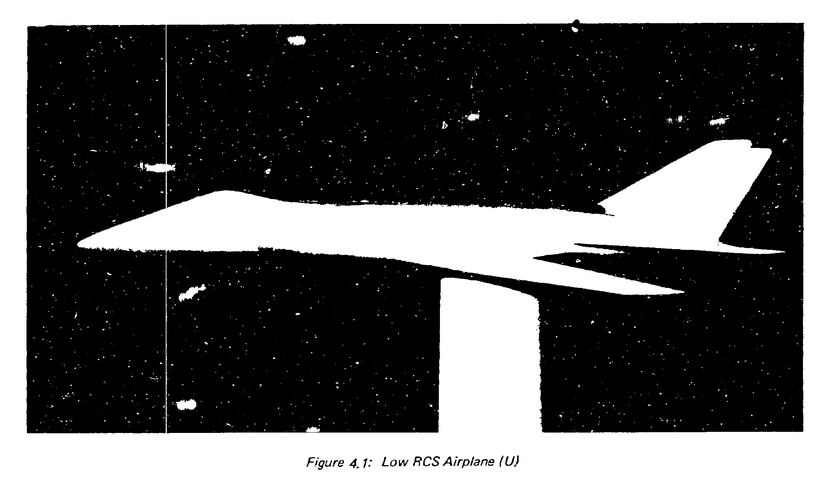
- Joined
- 27 December 2005
- Messages
- 17,752
- Reaction score
- 26,437
Highly swept wing is interesting.
Similar threads
-
-
-
McDonnell-Douglas Model 265 AFTI project
- Started by overscan (PaulMM)
- Replies: 79
-
Douglas Model 1209 High Speed Composite Bomber study of 1950
- Started by jzichek
- Replies: 2
-
McDonnell Douglas/NASA Langley propfan ADVANCED TACTICAL TRANSPORT (1989)
- Started by flateric
- Replies: 2

